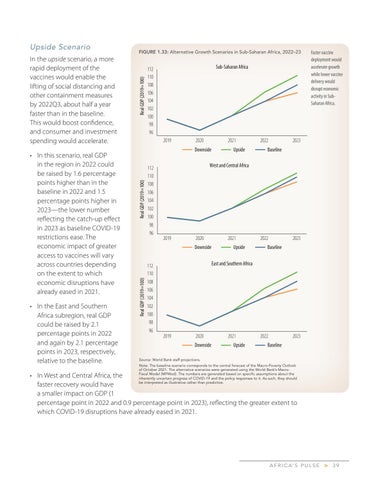• In this scenario, real GDP in the region in 2022 could be raised by 1.6 percentage points higher than in the baseline in 2022 and 1.5 percentage points higher in 2023—the lower number reflecting the catch-up effect in 2023 as baseline COVID-19 restrictions ease. The economic impact of greater access to vaccines will vary across countries depending on the extent to which economic disruptions have already eased in 2021. • In the East and Southern Africa subregion, real GDP could be raised by 2.1 percentage points in 2022 and again by 2.1 percentage points in 2023, respectively, relative to the baseline.
Real GDP (2019=100)
FIGURE 1.33: Alternative Growth Scenarios in Sub-Saharan Africa, 2022–23
Sub-Saharan Africa
112 110 108 106 104 102 100 98 96 2019
2020
2021
Downside
Real GDP (2019=100)
In the upside scenario, a more rapid deployment of the vaccines would enable the lifting of social distancing and other containment measures by 2022Q3, about half a year faster than in the baseline. This would boost confidence, and consumer and investment spending would accelerate.
112 110 108 106 104 102 100 98 96
112 110 108 106 104 102 100 98 96
Upside
2022
Faster vaccine deployment would accelerate growth while lower vaccine delivery would disrupt economic activity in SubSaharan Africa.
2023
Baseline
West and Central Africa
2019
2020 Downside
Real GDP (2019=100)
Upside Scenario
2021 Upside
2022
2023
Baseline
East and Southern Africa
2019
2020 Downside
2021 Upside
2022
2023
Baseline
Source: World Bank staff projections. Note: The baseline scenario corresponds to the central forecast of the Macro-Poverty Outlook of October 2021. The alternative scenarios were generated using the World Bank’s MacroFiscal Model (MFMod). The numbers are generated based on specific assumptions about the inherently uncertain progress of COVID-19 and the policy responses to it. As such, they should be interpreted as illustrative rather than predictive.
• In West and Central Africa, the faster recovery would have a smaller impact on GDP (1 percentage point in 2022 and 0.9 percentage point in 2023), reflecting the greater extent to which COVID-19 disruptions have already eased in 2021.
A F R I C A’ S P U L S E
>
39

